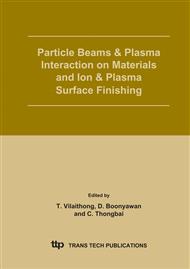p.63
p.69
p.75
p.81
p.87
p.95
p.99
p.103
p.107
Inactivation and Destruction of Bacillus Subtilis Using a Low Pressure Glow Discharge Plasma
Abstract:
Radicals like atomic oxygen, the hydroxyl OH and charged particles directly affect outer membranes of biological cells such as microorganisms. Low pressure glow discharges of oxygen and hydrogen peroxide (3% concentration H2O2) produced these radicals and charged particles, and their effect on the inactivation or destruction of Bacillus subtilis were investigated. Artificially contaminated 65 cm2 Petri dishes with a pure culture of the microorganism were used to test the efficiency of the plasma treatment. Cell density of the spore suspension of a 24-hour nutrient agar containing the culture is estimated at 1.5x109 cells/ml using standard plate count techniques. The effect of varied discharge conditions (450V and 500V), gas flow rate (20-60 sccm), sample temperature and exposure time (30-60 minutes) on the decimal reduction value (DRV or D-value), that is, the time required to inactivate or destroy 90% of the original population of microorganisms were determined. Results indicate that for the H2O2 plasma, at a discharge potential of 500V, the DRV is 11.83 minutes with a 99.6% destruction of microorganisms in 60 minutes. For oxygen plasma, the DRV is 10.57 minutes and 99.33% reduction in 60 minutes. The sample temperature in the H2O2 plasma exposure reached a maximum of 109 oC in an hour, while that in the oxygen plasma peaked at 46 oC in less than an hour. These DRV, cycle time and temperature values are much better when compared to common sterilization methods like autoclave, dry heat and gas like ethylene oxide.
Info:
Periodical:
Pages:
87-94
Citation:
Online since:
October 2005
Price:
Сopyright:
© 2005 Trans Tech Publications Ltd. All Rights Reserved
Share:
Citation:


